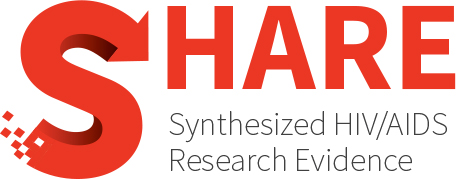Category Archives: Sexual risk behaviour
Is the sexual behaviour of young people in sub-Saharan Africa influenced by their peers? A systematic review
Adolescents in sub-Saharan Africa are highly vulnerable to HIV, other sexually transmitted infections (STIs) and unintended pregnancies. Evidence for the effectiveness of individual behaviour change interventions in reducing incidence of...
Factors underlying the success of behavioral HIV-prevention interventions for adolescents: a meta-review.
The purpose of this meta-review was to identify characteristics of successful HIV prevention interventions for adolescents based on quantitative (i.e., meta-analyses) and qualitative reviews published to date, and to inform...
Acculturation and HIV-related sexual behaviours among international migrants: A systematic review and meta-analysis
This review examines the global literature regarding the relationship between acculturation and HIV-related sexual behaviours among international migrants. Seventy-nine articles published in English-language journals prior to July 2012 met the...
Your blues ain’t like mine: Considering integrative antiracism in HIV prevention research with black men who have sex with men in Canada and the United States
Evidence-based interventions have been developed and used to prevent HIV infections among black men who have sex with men (MSM) in Canada and the United States; however, the degree to...
Hormonal contraceptive methods and risk of HIV acquisition in women: A systematic review of epidemiological evidence
Whether use of various types of hormonal contraception (HC) affect risk of HIV acquisition is a critical question for women’s health. For this systematic review, we identified 22 studies published...
Systematic review of couple-based HIV intervention and prevention studies: Advantages, gaps, and future directions
We conducted a systematic review of couple-based HIV biobehavioral (skills-building, VCT, and adherence) and biomedical (ART, circumcision) prevention and intervention studies designed to reduce sexual- and drug-risk behaviors and HIV...
A systematic review of interventions for reducing HIV risk behaviors among people living with HIV in the United States, 1988-2012
OBJECTIVE: To conduct a systematic review to examine interventions for reducing HIV risk behaviors among people living with HIV (PLWH) in the United States. METHODS: Systematic searches included electronic databases...
Factors related to risky sexual behaviors and effective STI/HIV and pregnancy intervention programs for African American adolescents.
OBJECTIVE: The purpose of this integrative literature review study was to investigate factors related to risky sexual behaviors among African American adolescents, to evaluate which of the factors are common...
HIV/AIDS and minority men who have sex with men: A meta-ethnographic synthesis of qualitative research
The World Health Organization (2009) estimates that there are as many as 33 million people currently living with HIV/AIDS throughout the world. Studies also reveal that racial disparities significantly influence...
A community empowerment approach to the HIV response among sex workers: Effectiveness, challenges, and considerations for implementation and scale-up
A community empowerment-based response to HIV is a process by which sex workers take collective ownership of programmes to achieve the most effective HIV outcomes and address social and structural...
